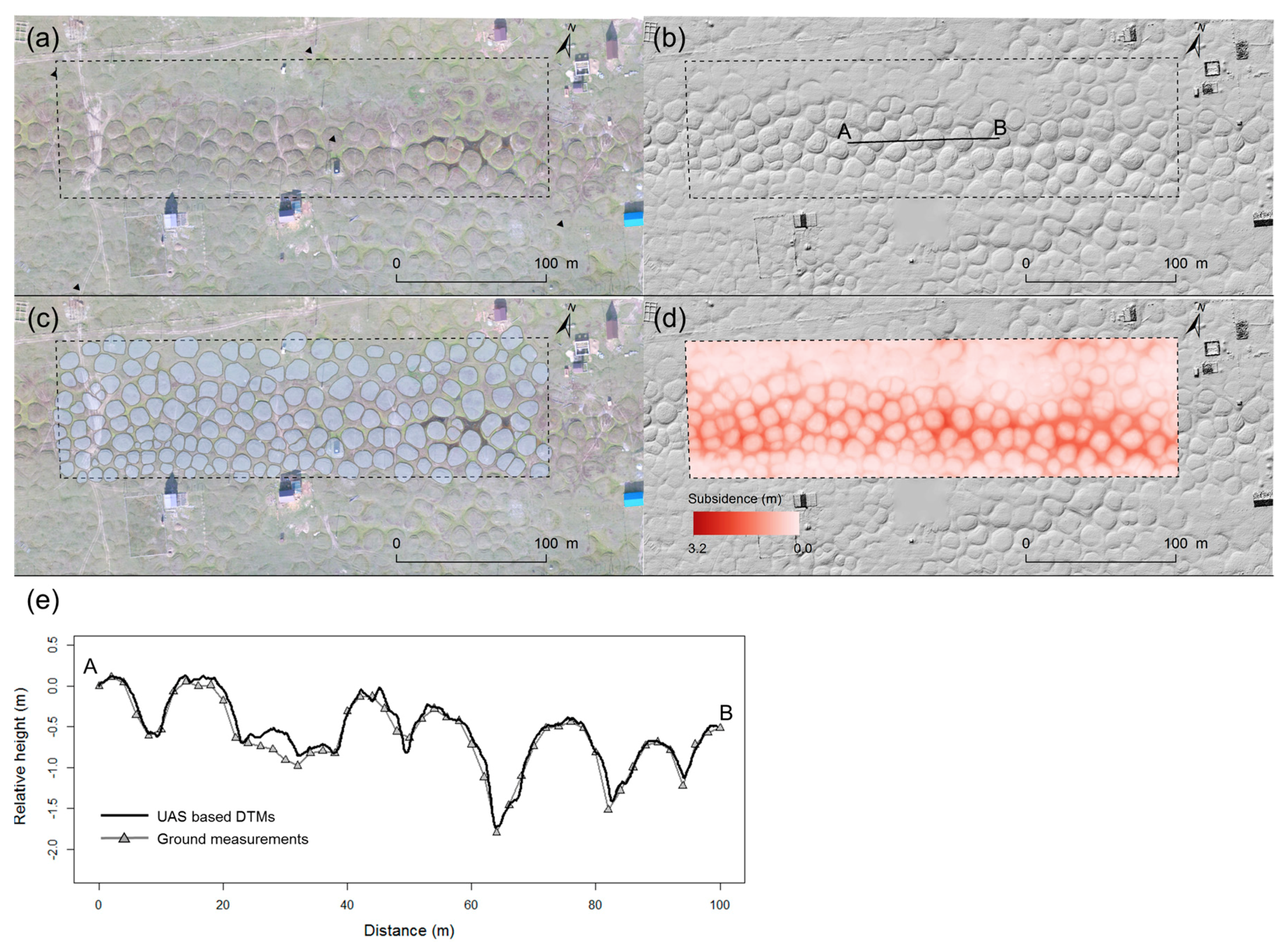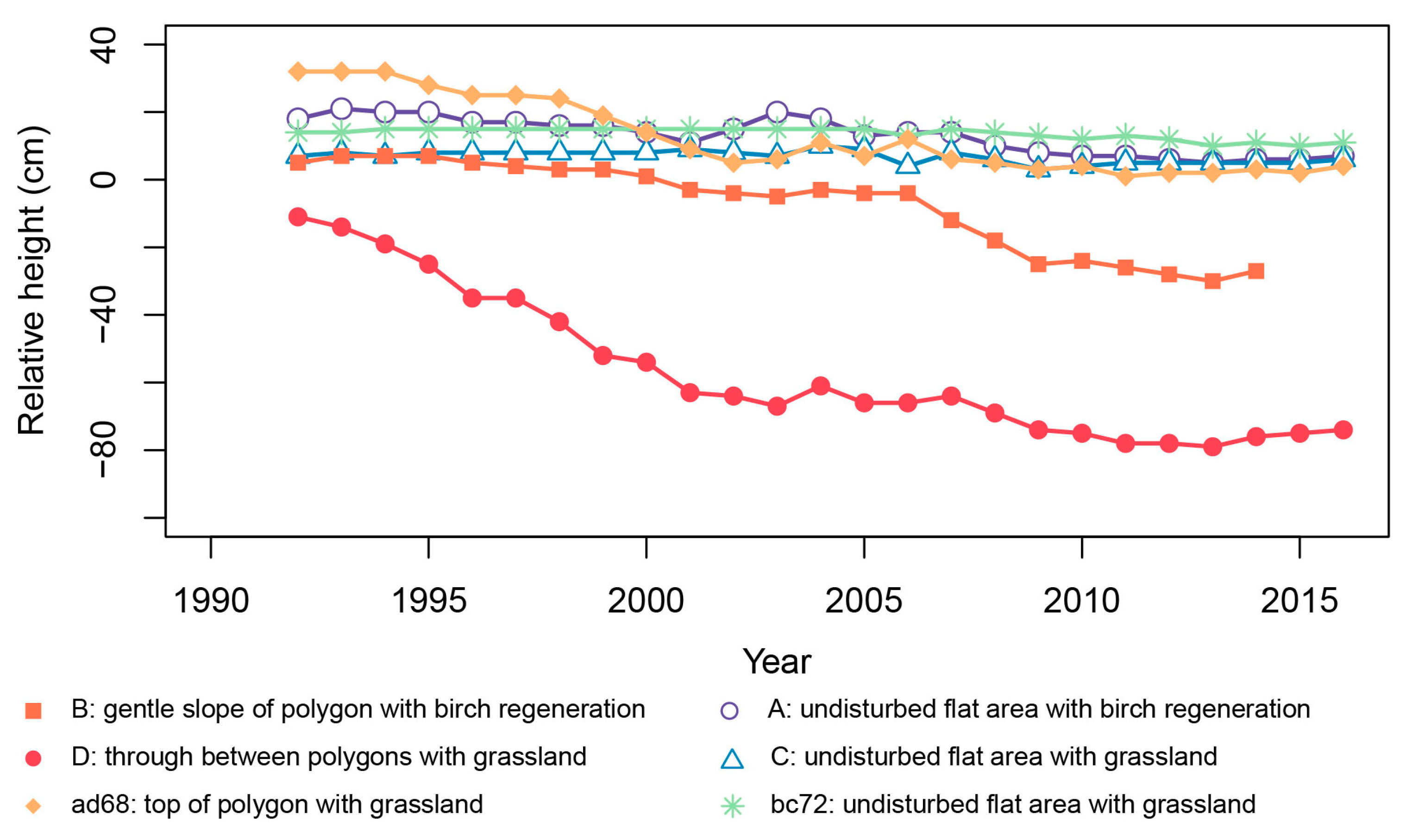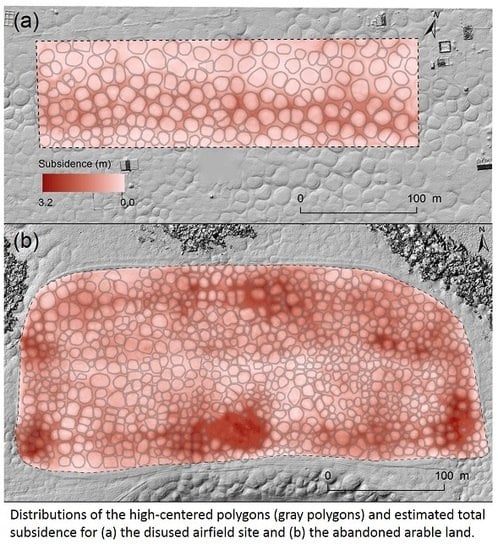Thermokarst Development Detected from High-Definition Topographic Data in Central Yakutia
Abstract
:1. Introduction
2. Study Area
3. Methods
4. Results
4.1. The Disused Airfield Site
4.2. The Abandoned Arable Land
5. Discussion
5.1. Size of Polygons and Subsidence
5.2. Advantages and Limitations of This Study
6. Conclusions
Author Contributions
Funding
Acknowledgments
Conflicts of Interest
References
- Washburn, A.L. Permafrost features as evidence of climatic change. Earth Sci. Rev. 1980, 15, 327–402. [Google Scholar] [CrossRef]
- Van Everdingen, R.O. Multi-Language Glossary of Permafrost and Related Ground-Ice Terms. International Permafrost Association, 2005. Available online: http://globalcryospherewatch.org/reference/glossary_docs/Glossary_of_Permafrost_and_Ground-Ice_IPA_2005.pdf (accessed on 8 September 2018).
- French, H.M. The Periglacial Environment, 3rd ed.; John Wiley & Sons: West Sussex, UK, 2007. [Google Scholar]
- Shur, Y.; Hinkel, K.M.; Nelson, F.E. The transient layer: Implication for geocryology and climate-change science. Permafr. Periglac. Process. 2005, 16, 5–17. [Google Scholar] [CrossRef]
- Grosse, G.; Romanovsky, V.; Jorgenson, T.; Anthony, K.W.; Brown, J.; Overduin, P.P. Vulnerability and feedbacks of permafrost to climate change. EOS Trans. AGU 2011, 92, 73–74. [Google Scholar] [CrossRef]
- Iwahana, G.; Uchida, M.; Liu, L.; Gong, W.; Meyer, F.; Guritz, R.; Yamanokuchi, T.; Hinzman, L. InSAR detection and field evidence for thermokarst after a tundra wildfire, Using ALOS-PALSAR. Remote Sens. 2016, 8, 218. [Google Scholar] [CrossRef]
- Iwahana, G.; Machimura, T.; Kobayashi, Y.; Fedorov, A.N.; Konstantinov, P.Y.; Fukuda, M. Influence of forest clear-cutting on the thermal and hydrological regime of the active layer near Yakutsk, Eastern Siberia. J. Geophys. Res. 2005, 110, G02004. [Google Scholar] [CrossRef]
- Iijima, Y.; Park, H.; Konstantinov, P.Y.; Pudov, G.G.; Fedorov, A.N. Active-Layer Thickness Measurements Using a Handheld Penetrometer at Boreal and Tundra Sites in Eastern Siberia. Permafr. Periglac. Process. 2017, 28, 306–313. [Google Scholar] [CrossRef]
- Crate, S.; Ulrich, M.; Habeck, J.O.; Desyatkin, A.R.; Desyatkin, R.V.; Fedorov, A.N.; Hiyama, T.; Iijima, Y.; Ksenofontov, S.; Mészáros, C.; et al. Permafrost livelihoods: A transdisciplinary review and analysis of thermokarst-based systems of indigenous land use. Anthropocene 2017, 18, 89–104. [Google Scholar] [CrossRef]
- Dubikov, G.I.; Aksenov, V.I.; Koreisha, M.M.; Murzaeva, V.E.; Poznanin, V.L.; Rivkin, F.M. Geocryological Glossary; GEOS: Moscow, Russia, 2003. (In Russian) [Google Scholar]
- Strauss, J.; Schirrmeistera, L.; Grosse, G.; Fortier, D.; Hugelius, G.; Knoblauch, C.; Romanovsky, V.; Schädelg, C.; von Deimling, T.S.; Schuur, E.A.G.; et al. Deep Yedoma permafrost: A synthesis of depositional characteristics and carbon vulnerability. Earth-Sci. Rev. 2017, 172, 75–86. [Google Scholar] [CrossRef]
- Efimov, A.I.; Grave, N.A. Buried ice of Abalakh lake area, Socialist construction. Yakutsk 1940, 10–11, 65–78. (In Russian) [Google Scholar]
- Soloviev, P.A. Permafrost of Northern Part of the Lena-Amga Interfluve; USSR Academy of Sciences: Moscow, Russia, 1959. (In Russian) [Google Scholar]
- Mil’kov, F.N. Dictionary-Reference on Physical Geography; Moscow: Mysl, Russia, 1970; 344p. (In Russian) [Google Scholar]
- Smith, L.C.; Sheng, Y.; MacDonald, G.M.; Hinzman, L.D. Disappearing arctic lakes. Science 2005, 308, 1429. [Google Scholar] [CrossRef] [PubMed]
- Schuur, E.A.G.; McGuire, A.D.; Schädel, C.; Grosse, G.; Harden, J.W.; Hayes, D.J.; Hugelius, G.; Koven, C.D.; Kuhry, P.; Lawrence, D.M.; et al. Climate change and the permafrost carbon feedback. Nature 2015, 520, 171–179. [Google Scholar] [CrossRef] [PubMed]
- Fedorov, A.N.; Gavriliev, P.P.; Konstantinov, P.Y.; Hiyama, T.; Iijima, Y.; Iwahana, G. Estimating the water balance of a thermokarst lake in the middle of the Lena River basin, eastern Siberia. Ecohydrology 2014, 7, 188–196. [Google Scholar] [CrossRef]
- Lopez Caceres, M.L.; Takakai, F.; Iwahana, G.; Fedorov, A.N.; Iijima, Y.; Hatano, R.; Fukuda, M. Snowmelt and the hydrological interaction of forest–grassland ecosystems in Central Yakutia, eastern Siberia. Hydrol. Process. 2015, 29, 3074–3083. [Google Scholar] [CrossRef]
- Skachkov, Y.B. Climate change trends in Central Yakutia at the turn of the 20th to 21st century. In Regional Environmental Response to Global Change: North-Earstern and Central Asia, Proceedings of the International Scientific Conference, Irkutsk, Russia, 17–21 September 2012; V.B. Sochava Institute of Geography SB RAS Publisher: Irkutsk, Russia, 2012; Volume 1, pp. 236–238. (In Russian) [Google Scholar]
- Iijima, Y.; Fedorov, A.N.; Park, H.; Suzuki, K.; Yabuki, H.; Maximov, T.C.; Ohata, T. Abrupt increases in soil temperature following increased precipitation in a permafrost region, central Lena River basin, Russia. Permafr. Periglac. Process. 2010, 21, 30–41. [Google Scholar] [CrossRef]
- Fedorov, A.; Konstantinov, P. Observations of surface dynamics with thermokarst initiation, Yukechi site, Central Yakutia. In Proceedings of the 8th International Conference on Permafrost, Zurich, Switzerland, 21–25 July 2003; AA Balkema: Lisse, The Netherlands, 2003; pp. 239–243. [Google Scholar]
- Günther, F.; Overduin, P.P.; Yakshina, I.A.; Opel, T.; Baranskaya, A.V.; Grigoriev, M.N. Observing Muostakh disappear: Permafrost thaw subsidence and erosion of a ground-ice-rich island in response to arctic summer warming and sea ice reduction. Cryosphere 2015, 9, 151–178. [Google Scholar] [CrossRef] [Green Version]
- Liljedahl, A.K.; Boike, J.; Daanen, R.P.; Fedorov, A.N.; Frost, G.V.; Grosse, G.; Hinzman, L.D.; Iijima, Y.; Jorgenson, J.C.; Matveyeva, N.; et al. Pan-Arctic ice-wedge degradation in warming permafrost and its influence on tundra hydrology. Nat. Geosci. 2016, 9, 312. [Google Scholar] [CrossRef]
- Liu, L.; Schaefer, K.M.; Chen, A.C.; Gusmeroli, A.; Zebker, H.A.; Zhang, T. Remote sensing measurements of thermokarst subsidence using InSAR. J. Geophys. Res. Earth Surf. 2015, 120, 1935–1948. [Google Scholar] [CrossRef]
- Westoby, M.J.; Brasington, J.; Glasser, N.F.; Hambrey, M.J.; Reynolds, J.M. ‘Structure-from-Motion’ photogrammetry: A low-cost, effective tool for geoscience applications. Geomorphology 2012, 179, 300–314. [Google Scholar] [CrossRef] [Green Version]
- Saito, H.; Uchiyama, S.; Obanawa, H.; Hayakawa, Y.S. Landslides triggered by an earthquake and heavy rainfalls at Aso volcano, Japan, detected by UAS and SfM-MVS photogrammetry. Prog. Earth Planet. Sci. 2018, 5, 15. [Google Scholar] [CrossRef]
- Karavaev, M.N. Paleogeographic reconstruction of landscapes of the Central Yakutian plain in the Cenozoic. Rep. Acad. Sci. USSR 1955, 102, 797–800. (In Russian) [Google Scholar]
- Krasyuk, A.A. The Soils of the Lena-Aldan Watershed. Materials of the Commission to Explore YASSR; Publishing House of the Academy of Sciences of the USSR: Moscow, Russia, 1927; 176p. (In Russian) [Google Scholar]
- Elovskaya, L.G. Classification and Diagnosis of Yakutia Permafrost Soils; Yakutian Section of the Siberian Branch of the Academy of Science USSR: Yakutsk, Russia, 1987; 172p. (In Russian) [Google Scholar]
- Gasanov, S.S. Estimating of the volumetric macro ice bodies content of permafrost in the development of placer deposit. Kolyma 1969, 6, 41–42. (In Russian) [Google Scholar]
- Scientific and Applied Reference Book on the Climate of the USSR; Issue 24, Yakut ASSR, Book 1; Gidrometeoizdat: Leningrad, Russia, 1989; 608p. (In Russian)
- Ivanov, M.S. The Cryogenic Structure of Quarternary Deposits of the Leno-Aldan Depression; Nauka: Novosibirsk, Russia, 1984; 125p. (In Russian) [Google Scholar]
- Fedorov, A.N.; Konstantinov, P.Y. Recent changes in ground temperature and the effect on permafrost landscapes in Central Yakutia. In Proceedings of the Ninth International Conference on Permafrost, University of Alaska Fairbanks, 29 June–3 July 2008; Kane, D.L., Hinkel, K.M., Eds.; Institute of Northern Engineering, University of Alaska Fairbanks: Fairbanks, AK, USA, 2008; pp. 433–438. [Google Scholar]
- Gavriliev, P.P.; Ugarov, I.S. Reaction of Central Yakutian ice complex on climate warming. Earth Cryosphere 2009, XIII, 24–30. (In Russian) [Google Scholar]
- Ulrich, M.; Hauber, E.; Herzschuh, U.; Härtel, S.; Schirrmeister, L. Polygon pattern geomorphometry on Svalbard (Norway) and western Utopia Planitia (Mars) using high-resolution stereo remote-sensing data. Geomorphology 2011, 134, 197–216. [Google Scholar] [CrossRef] [Green Version]
- Kühni, A.; Pfiffner, O. The relief of the Swiss Alps and adjacent areas and its relation to lithology and structure: Topographic analysis from a 250-m DEM. Geomorphology 2001, 41, 285–307. [Google Scholar] [CrossRef]
- Saito, H.; Nakayama, D.; Matsuyama, H. Comparison of landslide susceptibility based on a decision-tree model and actual landslide occurrence: The Akaishi Mountains, Japan. Geomorphology 2009, 109, 108–121. [Google Scholar] [CrossRef]
- James, L.A.; Hodgson, M.E.; Ghoshal, S.; Latiolais, M.M. Geomorphic change detection using historic maps and DEM differencing: The temporal dimension of geospatial analysis. Geomorphology 2012, 137, 181–198. [Google Scholar] [CrossRef]
- Romanovsky, N.N. Formation of Polygonal-Wedge Structures; Nauka Press: Novosibirsk, Russia, 1977. (In Russian) [Google Scholar]
- Ulrich, M.; Matthes, H.; Schirrmeister, L.; Schütze, J.; Park, H.; Iijima, Y.; Fedorov, A.N. Differences in behavior and distribution of permafrost-related lakes in Central Yakutia and their response to climatic drivers. Water Resour. Res. 2017, 53, 1167–1188. [Google Scholar] [CrossRef] [Green Version]






| UAS model | DJI Phantom4 |
| Airplane type | Rotorcraft |
| Weight | 1380 g |
| Max. duration of flight | Approx. 28 min. |
| Camera sensor | 1/2.3″ CMOS |
| Number of pixels | 12.4 M |
| GNSS receiver | EMLID Reach RTK |
| Frequency band | GPS L1, QZSS L1 |
| Study Area | Disused Airfield Site | Abandoned Arable Land | |
|---|---|---|---|
| Analyzed area (ha) | 3.0 | 6.3 | |
| Polygons | n = | 174 | 867 |
| density (/ha) | 57.6 | 137.8 | |
| Polygon area (m2) | minimum | 14.6 | 5.9 |
| average | 111.2 | 46.8 | |
| median | 116.0 | 40.4 | |
| maximum | 248.5 | 174.1 | |
| SD | 43.7 | 26.0 | |
| Diameter (m) | minimum | 4.3 | 2.7 |
| average | 11.6 | 7.4 | |
| median | 12.2 | 7.2 | |
| maximum | 17.8 | 14.9 | |
| SD | 2.5 | 2.0 | |
| Total subsidence (cm) | spatial average | 55.6 | 106.0 |
| maximum | 204.8 | 321.9 | |
| Total volume of subsidence (m3) | 1.7 × 104 | 6.7 × 104 | |
| Subsidence rate | spatial average | 2.1 | 3.9 |
| (1990–2017, cm/year) | maximum | 7.6 | 11.9 |
© 2018 by the authors. Licensee MDPI, Basel, Switzerland. This article is an open access article distributed under the terms and conditions of the Creative Commons Attribution (CC BY) license (http://creativecommons.org/licenses/by/4.0/).
Share and Cite
Saito, H.; Iijima, Y.; Basharin, N.I.; Fedorov, A.N.; Kunitsky, V.V. Thermokarst Development Detected from High-Definition Topographic Data in Central Yakutia. Remote Sens. 2018, 10, 1579. https://doi.org/10.3390/rs10101579
Saito H, Iijima Y, Basharin NI, Fedorov AN, Kunitsky VV. Thermokarst Development Detected from High-Definition Topographic Data in Central Yakutia. Remote Sensing. 2018; 10(10):1579. https://doi.org/10.3390/rs10101579
Chicago/Turabian StyleSaito, Hitoshi, Yoshihiro Iijima, Nikolay I. Basharin, Alexander N. Fedorov, and Viktor V. Kunitsky. 2018. "Thermokarst Development Detected from High-Definition Topographic Data in Central Yakutia" Remote Sensing 10, no. 10: 1579. https://doi.org/10.3390/rs10101579






